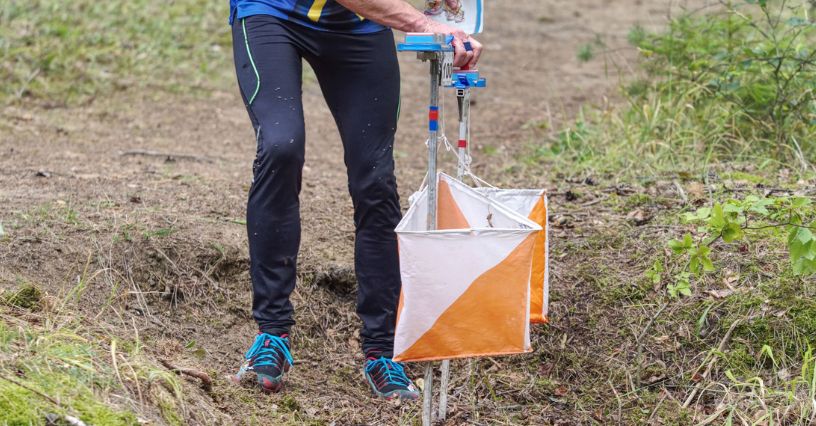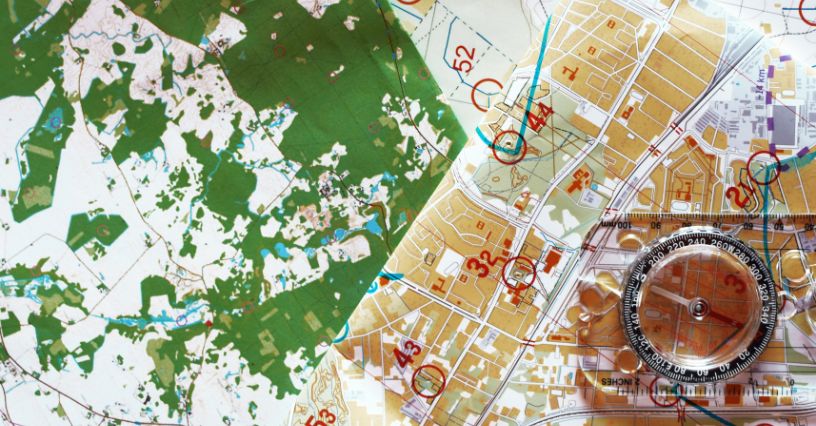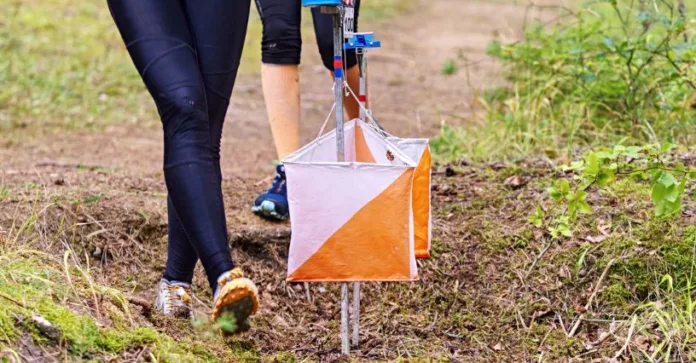If you run and enjoy competitions and have always been fascinated by the opportunity to explore forests, urban and mountain areas in a whole new way, then orienteering could be just what you are looking for.
Before you step on the start line of your first competition, check out what exactly OîA means, the basic principles of the sport and how to choose the right equipment and prepare for training sessions that will help you develop your running skills and navigation.
What is orientation in running?
Running orientation, in short OîA or from Eng. orienteering is a sport that combines running and orienteering. Competitors are given a map on which checkpoints (PCs) are marked, and their task is to reach them as quickly as possible and in a certain order. The competition can be individual or team. OîA takes place in different types of terrain, from parks to forests and urban areas. In orienteering, it is important not only to run fast, but also to be able to read a map, use a compass, plan a route and make navigation decisions in real time.
Running orienteering was born in Scandinavia in the second half of the 19th century, when soldiers used this form of training to improve their orienteering skills in unfamiliar terrain. The first official OîA competition took place in 1897 in Bergen, Norway. In the following years, orienteering grew in popularity, primarily in Scandinavia, and after World War II it began to be practiced in other European countries, including Norway, Denmark, Germany, and Switzerland. In 1961, the International Orienteering Federation (IOF) was established to coordinate international competitions, standardize the rules and promote the sport worldwide. The first World Orienteering Championships were organized in 1966 in Finland.
Orienteering in running – for whom?
If you’re an avid runner looking for a new challenge or someone who wants to combine physical activity with a passion for exploring unknown places, orienteering can be the perfect outdoor activity. Orienteering competitions include a variety of age categories and difficulty levels, allowing people of all ages, abilities and fitness levels to participate in these events.
Orientation in running – benefits
Practicing orienteering can bring many benefits, both physical and mental. Here are some of the reasons why it is worth practicing running orientation:
- strengthening muscles, improving aerobic capacity and general physical condition;
- developing navigational skills, including using the map, compass and other navigational tools to find control points and navigate the terrain, plan routes and make quick decisions;
- discovering new places and areas, both in the city and in different parts of Romania or the world;
- the opportunity to compete with other athletes, set personal records and overcome personal limits;
- flexibility and variety in choice of terrain and distance;
- the opportunity to meet new people with similar interests and build relationships with other players;
- developing cooperation and support skills.
Orienteering is not only a sport, but also fun and a reward for overcoming difficulties and achieving specific goals.

Orienteering – types
AîO competitions are organized in several categories for different age groups and experience levels. Depending on the length of the distance, we distinguish: sprint, middle and long distance.
Sprint
Orienteering sprint is a short and intense distance, usually 3-4 km. The route of a sprint race is through urban terrain (parks, urban developments, etc.). Sprints require quick navigational decisions and technical running skills.
Average distance
The average orientation distance is usually up to 6 km. The routes over this distance are varied in terms of terrain, covering forests, meadows and open areas. Middle distance requires a balance between running speed and sailing accuracy.
Long distance
Long-distance running orienteering usually involves 12-18 km routes through forests and mountainous terrain. The long distance requires physical endurance, a strong psyche and the ability to maintain focus for long periods of time.
relay race
The orienteering relay is a special form of competition in which teams are made up of several competitors, usually three. The distance in an orienteering relay can vary depending on the specific event and age category. Each competitor must complete the designated section of the course in the shortest possible time so that the team does not lose precious seconds.
OîA in the form of a relay requires effective communication within the team and an appropriate strategy, which includes decisions about the starting order of the athletes and tactics on the course.
Orientation in the night run
Regardless of the distance, orienteering can also take place after dark. Orientation at night presents additional challenges – using headlamps to read the map and find checkpoints in the dark is essential. Night time orientation starts at least 1 hour after sunset.
Basic rules of orientation
Orienteering has certain rules, the observance of which is essential for a fair, rewarding and safe competition. Here are the basic rules of the orienteering competition:
- individual or mass start – competitors can start individually, usually every few minutes, or mass start, meaning all participants start together;
- checkpoints – competitors must visit all checkpoints on the course in a certain order and prove that they have found them, for example: by presenting a special checkpoint card or a chip (SI – Sportident). Checkpoints are cube-shaped (white and red or white and orange) and marked with a code. In addition, they are increasingly equipped with an electronic sensor that allows the chip of a particular participant to be registered (the system emits a sound signal or a flash to confirm that the signal from the transmitter has been read). In the case of orientation at night, the checkpoints are additionally equipped with reflective elements;
- map and compass navigation – participants must use a map and compass to find control points and travel the shortest route between them. Competitors must not receive any external assistance, such as route directions, from anyone other than the team or the organisers;
- protecting the environment and moving through permitted areas – competitors must respect the environment in which the orienteering takes place, avoiding pollution, destruction of vegetation or disturbance of wildlife. In addition, participants must avoid passing through unauthorized areas such as private property, nature conservation areas, areas closed to the public, etc.
In addition, competitors must always comply with any additional instructions and guidelines issued by event organizers, including any route changes or additional safety rules. Violation of any running orientation rule may result in competitor or team disqualification. It is worth noting that OîA participants must be self-sufficient and be adequately prepared in terms of water, food and equipment supplies (usually a chip can be rented for a fee from the organizer for the duration of the event). They must be able to cope with possible difficulties such as disorientation or injury.

The compass and the map, i.e. the essential equipment for running orientation
The compass and map are integral tools that help orienteering athletes navigate the terrain. By combining the skills of using the two equipments, you can navigate efficiently, find control points and be successful in competitions. Mastering these skills takes time, practice and experience, but is essential to successfully navigating the terrain during OîA.
Property
The map prepared by the competition organizer in accordance with the ISSOM standard provides detailed terrain information such as topography, terrain types, geographical features and routes, thereby enabling competitors to make navigational decisions such as route selection, terrain difficulty assessment and planning the route to the destination. The standard scale used in orienteering is 1:15,000 or 1:10,000, but it can vary depending on the terrain and the type of competition.
Control points are marked on the map with symbols. Competitors must read these points and navigate to them on the field to confirm their acquisition. In addition, they must be able to determine the optimal route between checkpoints, taking into account terrain, slope, soil type and other factors. The map legend provides a key to the symbols and colors used on the map.
Compass
During the orienteering race, when the route is not clearly marked, the compass allows you to determine directions and helps you stay on course, which is crucial for navigating the terrain. In addition, the compass allows you to determine azimuths, or angles from north, so you can accurately determine the direction of control points on the map. Thumb compasses are often used in running orientation.

Orienteering in running – how to start?
Preparing to compete in orienteering requires a combination of physical training, honing sailing skills and adequate mental preparation.
Incorporate regular running into your training plan to improve your fitness, strength and endurance. In addition to long runs, do interval training to improve your speed, agility and ability to quickly adapt to changes in terrain. You can also sign up for regular training sessions with a club or group of runners specializing in OîA to improve your skills and gain experience in different terrain conditions.
Practice using your map and compass regularly to improve your navigation skills. Perform exercises in different terrain conditions to be prepared for a variety of routes. Learn to notice details such as land formations, geographic features and changes in vegetation that can be useful while sailing. Practice route planning before the start, taking into account terrain, compass directions, distances and expected crossing times between checkpoints. learn to read a map while running to gain precious seconds during the competition.
Another aspect is to define your initial goals. Remember that these must be realistic, measurable and appropriate to your level of ability. Your first goal might be to complete your first orienteering race, regardless of the outcome. Start with shorter routes for beginners. When you start, focus on gaining experience and learning the sport. Focus on ensuring your safety during competition and gaining confidence in navigating the terrain.
Once you’ve gained some experience, you can set a goal to improve your performance on future starts. This may include reducing the time spent on the route, visiting more checkpoints or increasing the efficiency of navigation. Analyze your route after each start, noting your strengths and weaknesses and what you can improve on in the future.



